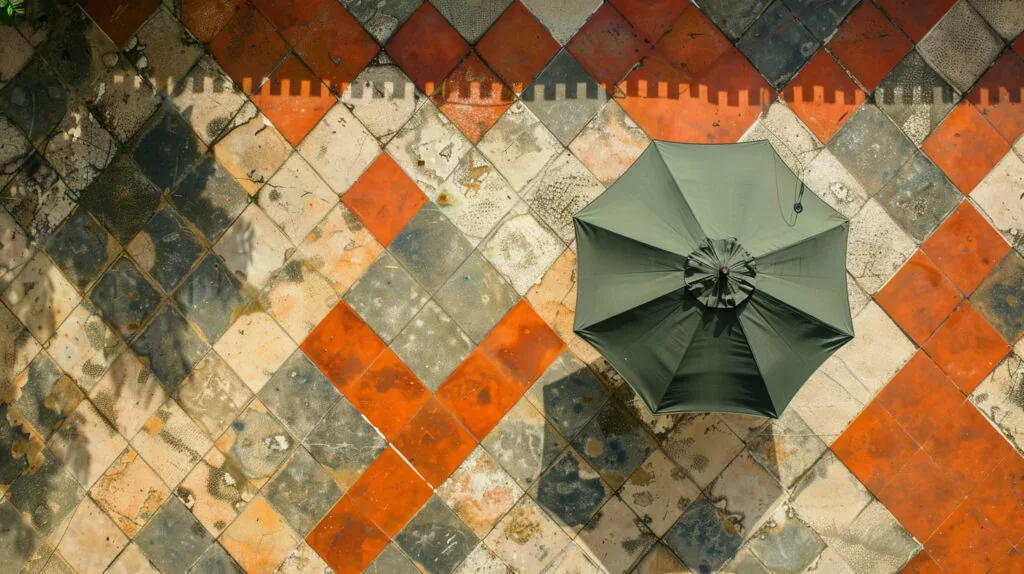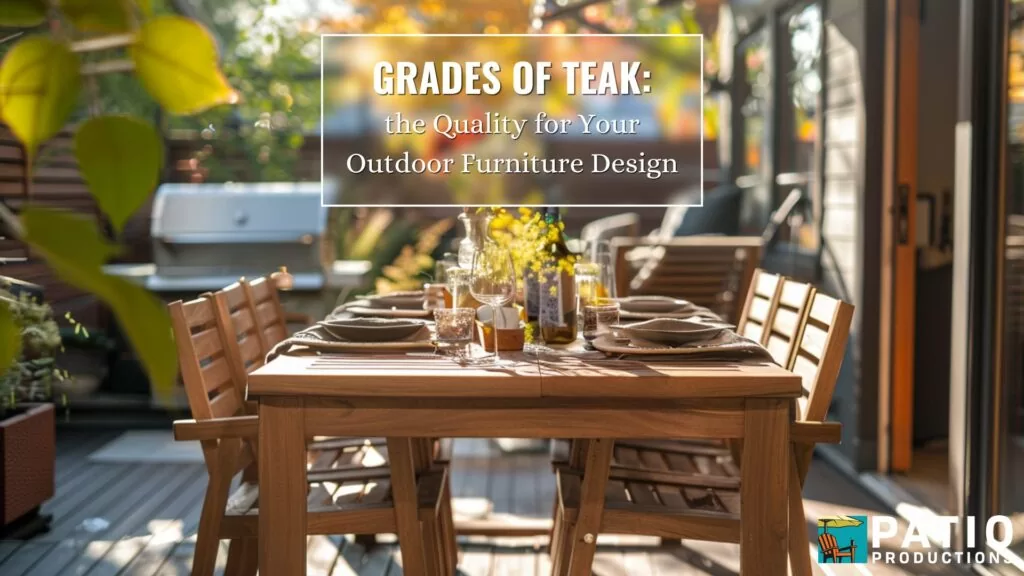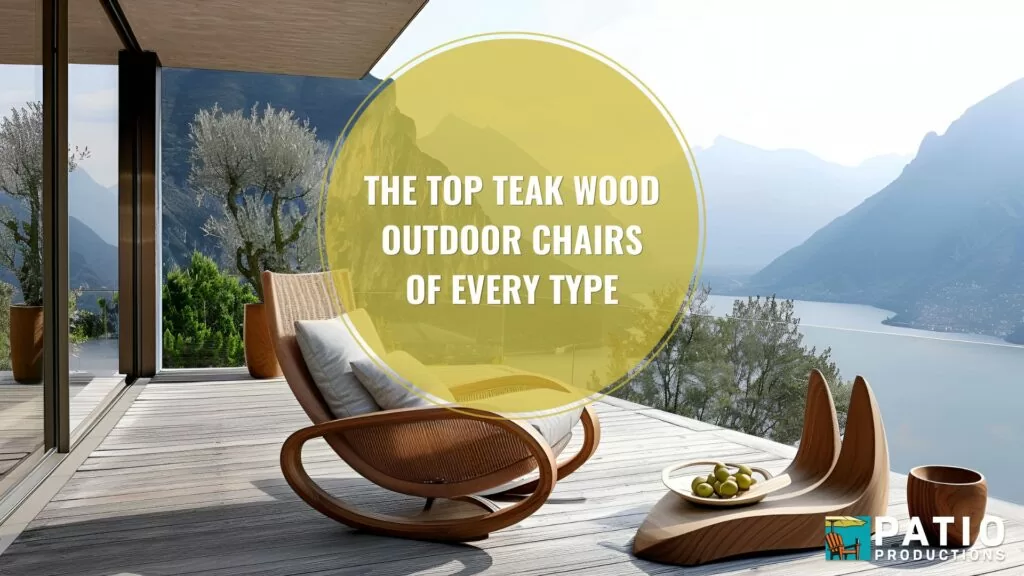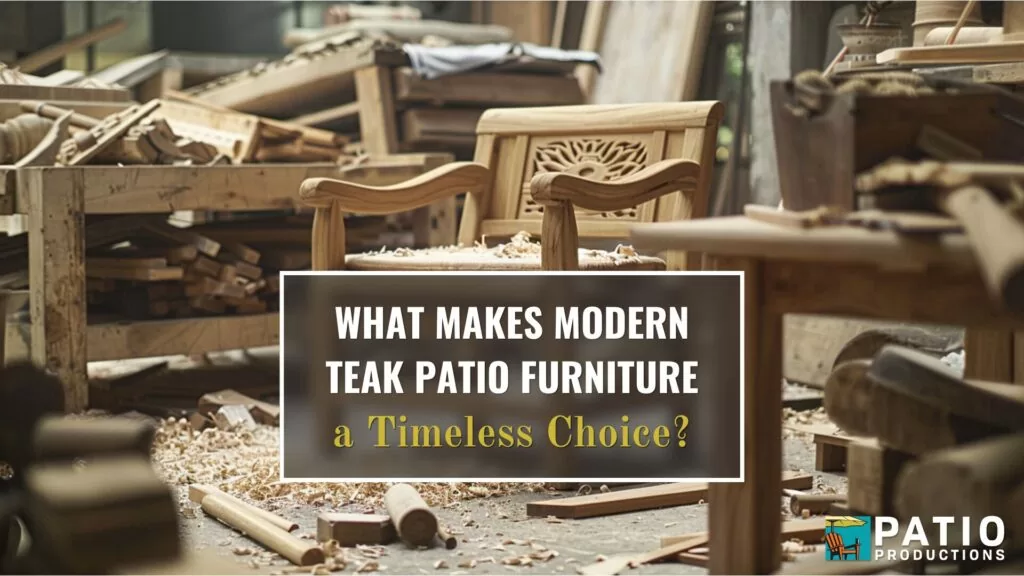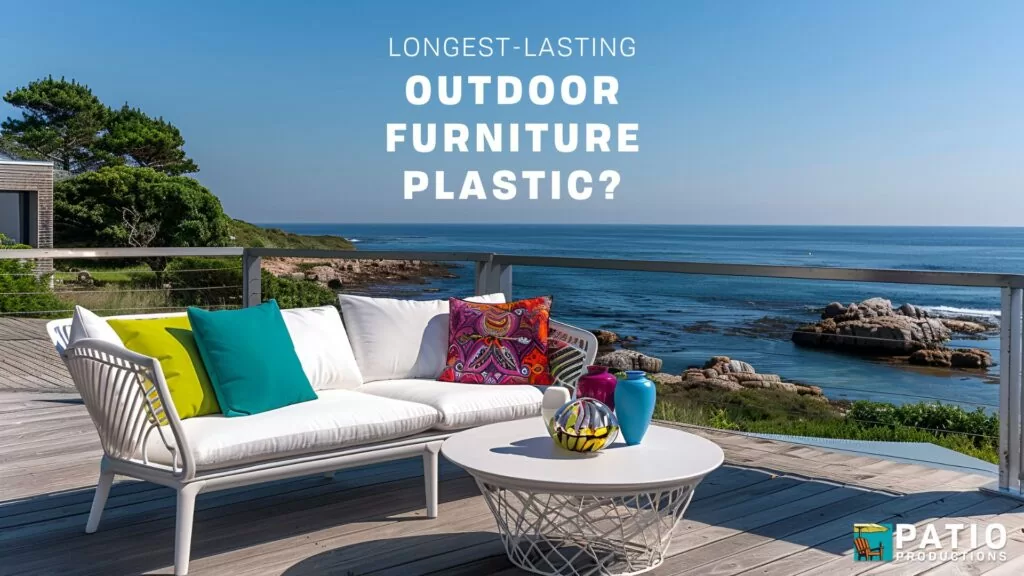Once you realize the quality, value, and eco-friendliness of composite outdoor furniture, you quickly begin to see all the great brands out there today. But once you begin to do some research, you realize there’s some confusing terminology out there right now. For instance, POLYWOOD is often mentioned as one of the leaders in the recycled plastic patio furniture industry, but it isn’t actually a composite (as it isn’t made with any wood fibers or materials). So, we’re comparing POLYWOOD vs other brands… what sets each apart, which is the best, and how do you choose the best composite patio furniture for your outdoor space?
Comparison Table: POLYWOOD vs. Other Leading Composite Brands
| Feature | POLYWOOD | Trex | Berlin Gardens | Seaside Casual |
|---|---|---|---|---|
| Material | Made in-house from recycled HDPE | Uses POLYWOOD’s recycled HDPE and other materials | PolyTuf Lumber (recycled HDPE & wood fibers) | EnviroWood (recycled HDPE & wood fibers) |
| UV-inhibitors? | Yes | Yes | Yes | Yes |
| Durability | High: resists weather, stains, scratches | High: resists weather, stains, scratches | High: resists weather, stains, scratches | High: resists weather, stains, scratches |
| Style Options | Classic & Modern designs, wide color range | Wood-like appearance, various colors | Traditional and modern, wood-like finishes | Blend of traditional and contemporary |
| Maintenance | Very low | Low | Very low | Very low |
| Price Range | $$ – $$$ | $$ – $$$ | $$$ | $$$ |
| Warranty | 20-year limited residential | 20-year limited residential | 20-year residential | 20-year limited residential |
| Unique Selling Point | Pioneer in recycled plastic furniture | Expertise in wood-like appearance | Amish craftsmanship | Designed for coastal environments |
| Product Range | Extensive | Limited furniture line, strong in decking | Wide range, including outdoor structures | Wide range of furniture and accessories |
| Manufacturing Location | USA | USA | USA | USA |
POLYWOOD is an early stand-out, but their custom material isn’t presented as a composite because of its lack of wood materials in the manufacturing process. Berlin Gardens, Trex, and Seaside Casual have all created reputations for making quality, reliable, stylish, and eco-friendly outdoor pieces made from composite materials. So before we begin picking apart each patio brand, let’s do a little level-setting.
Watch the summary video
The Rise of Composite Outdoor Furniture
There was definitely a time in outdoor furniture history when you really only had two choices: heavy, high-maintenance wood or flimsy plastic chairs that would fly away in a strong breeze. Luckily, we all left those days way behind us when composite materials came on the scene.
Modern composite outdoor furniture is generally made from a mix of recycled plastics and reused wood fibers. It is durable, low-maintenance, and eco-friendly, so you can understand how it’s become increasingly popular among outdoor living enthusiasts. And if you look at the differentiators for the brands we’re discussing today, you’ll begin to see why.
So to really understand all those differences and differentiators, let’s start with a brand that helped turn recycled plastic patio furniture into what it is today: POLYWOOD.

POLYWOOD: The Pioneer of Recycled Plastic Furniture
Since our whole goal is comparing POLYWOOD vs other brands, let’s start with POLYWOOD. This team entered the market in the 1990s, and has since developed a unique approach to recycled plastic manufacturing: turning recycled plastics (primarily milk jugs) into outdoor furniture with as little waste as possible. According to their CEO, “we recycle an average of 400,000 milk jugs a day.” That’s a LOT of plastic not going into landfills or oceans. And while it sounds unconventional, this eco-friendly approach to outdoor furniture manufacturing has helped make POLYWOOD one of this industry’s leaders.
It’s worth noting that this focus on only using recycled HDPE does make their furniture stand out in another way – its weight. POLYWOOD furniture is known to be denser (which helps with its durability), but also makes it harder to lift or move around. And if you’re putting larger POLYWOOD pieces on a space where weight should be considered (like on a wooden deck, between support beams or joists), you’ll want to make sure that extra weight won’t be an issue.
I asked Ben Harvey (the CEO of Patio Productions, and long-time champion of eco-friendly outdoor living) his thoughts on POLYWOOD.
“It’s a totally vertically integrated brand. They buy the milk jugs, grind them up, make the HDPE pellets, and turn that into faux lumber to make their furniture and cushions.” You can imagine the level of control that gives them over their final product. “POLYWOOD has the deepest offering of collections and colors of all the Poly Lumber brands, and they offer the best price and value.”
What Makes Polywood Stand Out?
- Sustainability: the company recycles an average of 400,000 milk jugs every day, significantly reducing plastic waste in landfills. And they operate with a zero-waste mindset. Since their manufacturing process is fully vertically integrated, they are able to gather, reconstitute, and reuse 99% of the HDPE scraps produced during the construction process.
- Durability: POLYWOOD products are built to last, with a reported lifespan of up to 50 years.
- Weather Resistance: POLYWOOD furniture is designed to withstand various weather conditions, including rain, snow, and intense sunlight.
- Low Maintenance: These products require minimal upkeep, needing only occasional cleaning.
- Color Options: POLYWOOD uses UV-inhibited pigments, resulting in vibrant colors that resist fading. Plus, the color runs throughout the composite material, making those inevitable scratches less noticeable.
POLYWOOD’s Recent Designer Series
With a brand that’s been in the game as long as POLYWOOD has, you could understand if style or quality had become stale. But POLYWOOD continues to push the industry.
Budget-minded shoppers can still choose POLYWOOD’s popular, unbeatably-priced traditional product lines (which look great despite a fit-and-finish that can fall short of more expensive patio furniture). But they’ve recently released their PW Designer Series, which is crafted with a more modern, sophisticated, elevated design aesthetic.


The Contenders: Other Composite Brands

Trex: Decking Expertise Applied to Furniture
If you did a web search for Trex, you’d probably first find them as a decking solution outfit. But they’re not a one-trick pony, and over the years have expanded into the outdoor furniture market. So, how do they stack up against POLYWOOD?
- Material Composition: Trex uses a proprietary blend of recycled wood fibers and recycled plastic film, allowing their products to closely mimic the look and feel of natural wood. They’ve also incorporated using POLYWOOD’s HDPE lumber.
- Manufacturing Process: Trex uses a co-extrusion process that creates a protective shell around the core material, so their patio furniture boasts durability and stain resistance in line with our other brands here.
- Product Offerings: Trex’s furniture line is limited compared to the other brands listed here today. They offer Adirondack chairs, rockers, side tables, and conversation sets. They also offer customizable options for color and cushions.
- Warranty: Trex provides a 20-year limited residential warranty for their outdoor furniture, comparable to POLYWOOD’s offering.

Berlin Gardens: Amish Craftsmanship Meets Modern Materials
Berlin Gardens brings a wonderfully unique blend of traditional and modern to their composite furniture lines. You’ll see Amish woodworking techniques with modern, recycled materials to create stylish, durable, planet-friendly outdoor furniture.
- Material Composition: Berlin Gardens uses a high-grade poly lumber called PolyTuf, made almost exclusively from recycled HDPE and wood fibers.
- Manufacturing Process: One of the things that sets Berlin Gardens apart is their process which involves both advanced machinery and hand-crafting techniques. So the buyer ends up with patio furniture boasting exceptional attention to detail. If Berlin Gardens has a lead on anything, it’s right here.
- Product Offerings: Berlin Gardens offers a wide range of products, including dining sets, lounge chairs, gliders, and even pergolas. They’re great reputation is based on their ability to create natural wood-like finishes on poly lumber.
- Warranty: Berlin Gardens provides a 20-year residential warranty on their poly lumber products, matching POLYWOOD’s warranty terms.

Seaside Casual: Traditional Elegance Meets Modern Materials
Our final entry into today’s POLYWOOD vs other brands comparison is Seaside Casual. This organization was born on the East Coast over 100 years ago, and they over two decades of composite furniture experience to the market, with a focus on creating durable pieces that can withstand coastal environments.
- Material Composition: Seaside Casual uses a proprietary material called EnviroWood, which is (yet another) high-density polyethylene (HDPE) based composite with added recycled wood materials.
- Manufacturing Process: Their furniture is crafted to withstand the harsh conditions of seaside environments, particularly the corrosive effects of salty air. I don’t know if you’ve lived on a coast, but that salt can wreak havoc on patio furniture. Seaside Casual makes quality stuff!
- Product Offerings: Seaside Casual offers a wide range of products including chairs, benches, dining sets, and accessories in a variety of styles often blending traditional aesthetics with modern materials.
- Warranty: Seaside Casual provides a 20-year limited warranty on their EnviroWood products for residential use. (Are you seeing a theme? These brands are the best, and they stand by their products!)
The Showdown: POLYWOOD vs. The Rest
In this POLYWOOD vs other brands deep dive, we’ve explored each brand and what makes them stand apart. Now let’s set them all side-by-side and see which stands above the rest!
Durability
POLYWOOD offers impressive durability with a 20-year warranty and products reportedly lasting up to 50 years. However, it’s important to note that other brands like Trex and Berlin Gardens also offer long-lasting products, with comparable 20-year warranties for their residential lines. We’re going to have to call this a draw.
WINNER: It’s a tie!

Style and Design
While POLYWOOD offers a range of styles, brands like Trex and Berlin Gardens have their unique strengths. Seaside Casual and Trex excel at mimicking real wood, which may appeal to those seeking a more traditional or natural look. Berlin Gardens, with its Amish craftsmanship, offers exceptional attention to detail and unique finishes that closely resemble natural wood.
More helpful insights from Ben Harvey: “I would need to know the customer’s goals, but for customers looking for heirloom quality outdoor furniture with exceptional comfort, I would point them to Berlin Gardens or Seaside Casual.
WINNER: Berlin Gardens or Seaside Casual

Eco-Friendliness
Surprise, surprise – we have another tight race in POLYWOOD vs other brands for eco-impact. All three brands demonstrate a strong commitment to sustainability by using recycled materials. But POLYWOOD’s vertically-integrated manufacturing and laser focus on zero waste are truly impressive.
WINNER: POLYWOOD
Price
Recycled pastic-based patio furniture generally comes at a premium compared to many traditional materials. But that’s not to say those looking for the right balance of quality and budget are out of luck. Both POLYWOOD and Trex offer more budget-friendly product lines. If you find yourself hunting for composite deals, just make sure to check that those decades-long warranties are still available.
WINNER: POLYWOOD

Comfort and Ergonomics
Comfort is another subjective area for critique. Everything from available styles, cushions, and even size of the pieces have a big impact on how much any given shopper will enjoy a piece of composite patio furniture. But all of these brands have invested in ergonomic, comfortable designs. POLYWOOD has several patented contoured designs, Trex and Seaside Casual focus on mimicking the comfort of traditional wooden furniture, and Berlin Gardens offers customizable options for optimal comfort.
I’ve seen reviews on a few of these brands that claim the pieces are poorly sized. But I have a cousin who’s 6’10” and a mother-in-law whose feet don’t touch the floor when sitting on a standard sofa. So, it’s hard to down-rate any one brand for such a wide range of user needs. You just have to go try out each piece and see what’s best for you.
WINNER: Tie!
Making Your Choice: What to Consider
Who’s the ultimate winner? You are, really. These brands are all worth a look for any discerning composite patio furniture shopper, and you just need to look at all the variables at play.
- Budget: Determine your price range and consider long-term value.
- Style: Decide whether you prefer POLYWOOD’s classic look, Trex’s wood-mimicking appearance, or Berlin Gardens’ unique finishes.
- Durability: Compare warranty terms and reported product lifespans.
- Maintenance: Consider how much time you’re willing to spend on upkeep.
- Eco-Friendliness: Look into each brand’s sustainability practices and recycled material usage.

The Bottom Line
So, is there a winner in this POLYWOOD vs other brands stand-off? (I hate to be a broken record, but…) With all of these great composite and recyled HDPE options available, the shopper ends up winning in the end. POLYWOOD’s long-held reputation as a front-runner is real, flexing some serious durability, low maintenance, and eco-friendliness muscle. But we also love offering Berlin Gardens and Seaside Casual because you get to shop a wider range of high-quality luxury pieces with their own unique styles. I mean, I call that a win.
Like Ben would say, the best outdoor furniture is whatever meets your specific needs and preferences. So, POLYWOOD, Berlin Gardens, Seaside Casual or any of our other luxury HDPE brands… the most important thing is that it enhances your outdoor living experience while going the distance in durability.
And with that in mind, enjoy Bringing Life Outdoors, my friends! We hope to see you at our San Diego showroom (we’ll keep a comfortable seat ready for ya.)

Eben Jol is a creative media specialist with over 10 years of experience creating helpful content for outdoor brands. In that time he has learned the ins and outs of the outdoor industry and has a keen understanding of what topics customers and information seekers need to know when they are planning and furnishing their outdoor space. He has gathered data and reported on industry insights for organizations such as the ICFA, and in his spare time, loves relaxing in his own backyard (and the great outdoors at large) with his wife and 3 kids.



